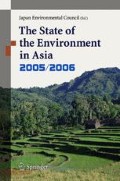Access this chapter
Tax calculation will be finalised at checkout
Purchases are for personal use only
Preview
Unable to display preview. Download preview PDF.
Notes
FAO, State of the World’s Forests 2001, 2001.
FAO, Forest Resources Assessment 1990: Global Synthesis. This is the 1980–1990 average for the Asia-Pacific region.
IGES Forest Conservation Project, Research Report on Phase I Strategy, The Institute for Global Environmental Strategies, 2001, p. 95 (in Japanese).
Yamane, M. and Chantirath, Khampha, “Lao Cypress Forests: Causes of Degradation and the Present State of Conservation in Lao, P. D. R.,” International Review for Environmental Strategies, vol. 1, no. 1, 2000, pp. 119–133.
For details, see: Verolme, H. J. H. and Moussa, J., Addressing the Underlying Causes of Deforestation and Forest Degradation, Case Studies, Analysis, and Policy Recommendations, Biodiversity Action Network, 1999, Washington, DC.
Japan’s rice paddies have a storage capacity of about 5.1 billion tons of water, or about twice that of flood-control dams. See: Tabuchi, Toshio, Rice Paddies of the World and Japan, Noson Gyoson Bunka Kyoukai, 1999, p. 160 (in Japanese).
In areas with steep topography and heavy rainfall, the dikes surrounding terraced paddies and fields prevent soil erosion. Ibid., p. 166.
Moriyama, Hiroshi, The Value of Preserving Rice Paddies, Noson Gyoson Bunka Kyoukai, 1997, p. 49 (in Japanese).
Rieley, J. O., Susan, P. E. and Notohadiprawiro, T., The Mega Rice Land Conservation Project in Central Kalimantan, Indonesia: Unsustainable Development, 2000.
Suzuki, Kenji and Goto, Akira, “Environmental Conditions of Rainwater-fed Rice Agriculture in Northeast Thailand and the Anatomy of Agricultural Projection,” Fujita, Kazuko, ed., Water and Social Milieu in Monsoon Asia, Sekai Shisousha, 2002, p. 124 (in Japanese); Sansanee, Choowaew, “Ricefield Agro-ecosystem and Biodiversity Conservation in the Lower Central Plain of Thailand,” presentation at INTECOL VI, 2000.
Tsujii, Tatsuichi, “Paddy Field of Hokkaido: The Transition of Rice Agro-ecosystem in Northern Limit of Japan and its Impact on the Environment,” presentation at INTECOL VI, 2000.
Moriyama, Hiroshi and Sprague, David S., Traditional Paddy Field Landscape Acted to Preserve Japanese Dragonfly Fauna, 2000.
Nakamura, Reiko and Hironaka, Kazumi, “Role of Rice Paddy as Wintering Habitat for Grus Monacha: A Case of Yashiro Valley, Japan”; Yamamoto, Hironobu, “Management and Conservation Strategies of Katano-Kamoike which is the Smallest Ramsar Site in Japan,” both presentations at INTECOL VI, 2000.
Harada, Yuriko, “The Domestic Laws on the Conservation of Biodiversity of Rice Agro-ecosystem in Japan,” presentation at INTECOL VI, 2000.
Report by the Bangladesh Rice Research Institute.
Hossain, Sanowar, “Rice Agro-ecosystem of Bangladesh: Sustainability through Integrated Farming Approach,” presentation at INTECOL VI, 2000; Hossain, MZ, “Sustainable Use of Wetland Flood Plain Paddy Fields in Bangladesh,” Asian Wetland Symposium Summary, 2001.
Ali, Ahyaudin Bin, “Fish sauna biodiversity in the Malaysian rice agro-ecosystem,” 2000; Manor, Mashor, “Biodiversity of aquatic flora in the rice agro-ecosystem of Malaysia: the impact of human intervention,” both presentations at INTECOL VI, 2000.
Salmah, Che, “Biodiversity of dragonfly in the rice agro-ecosystem of Malaysia as an indicator of ecosystem robustness,” presentation at INTECOL VI, 2000.
Kuwabara, Ren, and Satrawaha, R., “Agro-Ecosystem of Rice: Fish Culture and the Annexed Ponds in Northeast Thailand and Laos,” presentation at INTECOL VI, 2000.
Editor information
Editors and Affiliations
Rights and permissions
Copyright information
© 2005 Springer-Verlag Tokyo
About this paper
Cite this paper
Hiroji, I., Masanobu, Y., Yuriko, N., Makoto, I. (2005). Forest and Rice Paddy Biodiversity: Working Toward Comprehensive Management Based on Community Participation. In: Takehisa, A., Shun’ichi, T. (eds) The State of the Environment in Asia. Springer, Tokyo. https://doi.org/10.1007/4-431-27403-0_5
Download citation
DOI: https://doi.org/10.1007/4-431-27403-0_5
Published:
Publisher Name: Springer, Tokyo
Print ISBN: 978-4-431-25028-9
Online ISBN: 978-4-431-27403-2
eBook Packages: Earth and Environmental ScienceEarth and Environmental Science (R0)

